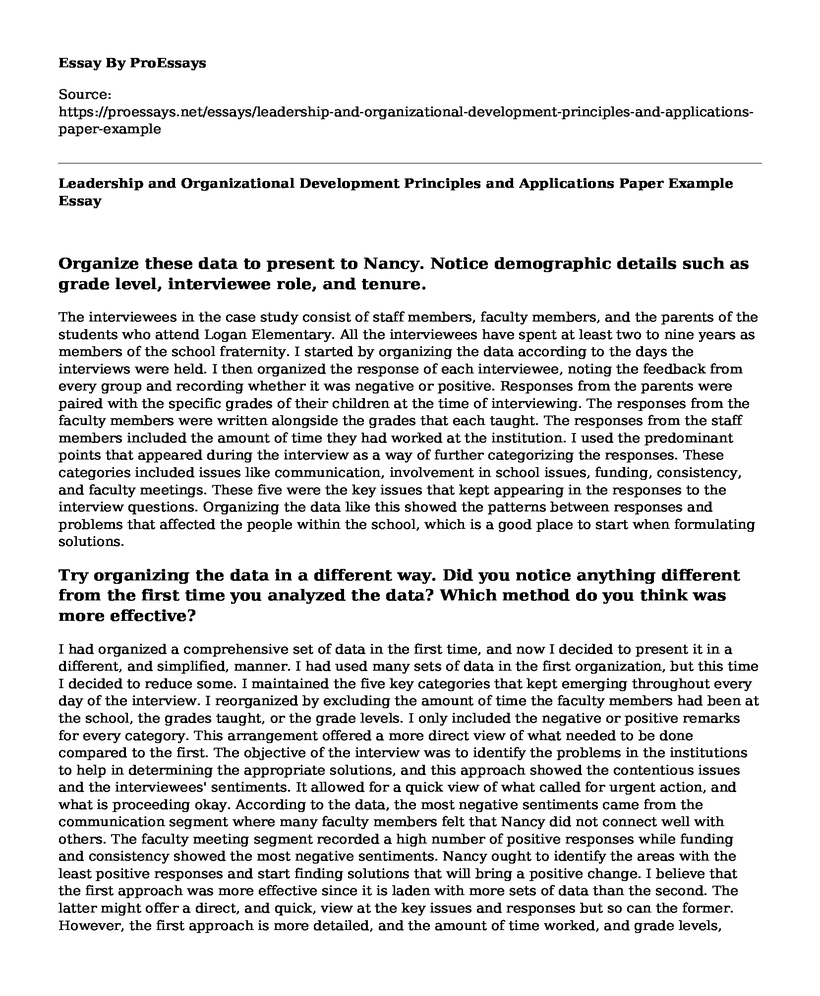Organize these data to present to Nancy. Notice demographic details such as grade level, interviewee role, and tenure.
The interviewees in the case study consist of staff members, faculty members, and the parents of the students who attend Logan Elementary. All the interviewees have spent at least two to nine years as members of the school fraternity. I started by organizing the data according to the days the interviews were held. I then organized the response of each interviewee, noting the feedback from every group and recording whether it was negative or positive. Responses from the parents were paired with the specific grades of their children at the time of interviewing. The responses from the faculty members were written alongside the grades that each taught. The responses from the staff members included the amount of time they had worked at the institution. I used the predominant points that appeared during the interview as a way of further categorizing the responses. These categories included issues like communication, involvement in school issues, funding, consistency, and faculty meetings. These five were the key issues that kept appearing in the responses to the interview questions. Organizing the data like this showed the patterns between responses and problems that affected the people within the school, which is a good place to start when formulating solutions.
Try organizing the data in a different way. Did you notice anything different from the first time you analyzed the data? Which method do you think was more effective?
I had organized a comprehensive set of data in the first time, and now I decided to present it in a different, and simplified, manner. I had used many sets of data in the first organization, but this time I decided to reduce some. I maintained the five key categories that kept emerging throughout every day of the interview. I reorganized by excluding the amount of time the faculty members had been at the school, the grades taught, or the grade levels. I only included the negative or positive remarks for every category. This arrangement offered a more direct view of what needed to be done compared to the first. The objective of the interview was to identify the problems in the institutions to help in determining the appropriate solutions, and this approach showed the contentious issues and the interviewees' sentiments. It allowed for a quick view of what called for urgent action, and what is proceeding okay. According to the data, the most negative sentiments came from the communication segment where many faculty members felt that Nancy did not connect well with others. The faculty meeting segment recorded a high number of positive responses while funding and consistency showed the most negative sentiments. Nancy ought to identify the areas with the least positive responses and start finding solutions that will bring a positive change. I believe that the first approach was more effective since it is laden with more sets of data than the second. The latter might offer a direct, and quick, view at the key issues and responses but so can the former. However, the first approach is more detailed, and the amount of time worked, and grade levels, could be used to form a clear picture of why the interviewees responded how they did.
How would you structure the feedback meeting with Nancy? Which themes would you present and why?
The textbook recommends beginning with the most positive information on the decision-maker when providing feedback. Avoiding assumptions, attention to detail, and using the proper language are other strategies to use while giving feedback to Nancy. I will start with the positive responses where interviewees felt that Nancy was highly involved in school activities and faculty meetings. When presenting the themes, I will ensure that they are manageable, descriptive, sufficient, and relevant. Nancy's aims from the beginning were, to build a consistent approach among the teachers at every grade level, to improve the relationships between staff and faculty, and to improve the relationship between the community and the school. Therefore, I will focus on the core themes including, Nancy's communication, involvement, and consistency because they will be the most beneficial and effective in enabling her to achieve all her objectives.
Cite this page
Leadership and Organizational Development Principles and Applications Paper Example. (2022, Oct 03). Retrieved from https://proessays.net/essays/leadership-and-organizational-development-principles-and-applications-paper-example
If you are the original author of this essay and no longer wish to have it published on the ProEssays website, please click below to request its removal:
- The Acquisition of LinkedIn by Microsoft Paper Example
- The Influence of Groups in Ancient Societies and Cleopatra's Leadership Essay
- Research Paper on AI Innovation and Project Management in Atos
- Ratio Analysis & Risk Mgmt: Essential Tools for Business Growth - Research Paper
- Students as Stakeholders: Leveraging Apps for Efficient Education - Essay Sample
- Effective Teamwork: Our Group Discussion - Essay Sample
- Essay Example on 4 Topics of Management: A Comprehensive Analysis







